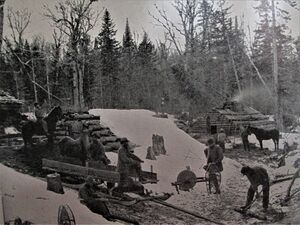Biography
Gain was born in 1819. He was the son of James Taylor and Mary Bartlett. He grew up in Burton but moved to the Portland ward of the city of Saint John after he married. Gain married Elizabeth Reynolds in August 1851 (*) "m. 28th ult., St Luke's Church, Portland by Rev. Wm. Harrison, Gain TAYLOR, Maugerville (Sunbury Co.) / Sarah Elizabeth Reynolds d/o James Reynolds of Indiantown (St. John)." Gain and Elizabeth had five children; Helen, William, Anne, Alberta and Gain. Gain worked as a raftsman and lumberman which was the number one industry in the province. Both he and his wife lived long lives. She passed away in 1904 and Gain died in 1906. He was 87 and the cause of death was listed as "old age."
New Brunswick's Timber Trade in the 1800's
The timber industry fueled New Brunswick's economy during the Colonial period. At the time of the Napoleonic Wars (1803-1815) 85% of the population was engaged in the timber trade. After the war the great pine forests were nearly exhausted but the supply of spruce seemed limitless. The British government encouraged New Brunswick's timber trade by applying heavy duties on foreign competition, mainly from the Baltic region.
But the price of wood was not stable. It fluctuated wildly. Many New Brunswickers invested in stands of timber, mill-rights and locations for dams only to see the price for timber plunge. Gain Taylor's grandfather had been a speculator and lost his fortune. Gain chose instead to keep a steady job cutting down the trees in the forest and rafting the logs to market. It served him well. He didn't retire until he was in his mid-70s.
The huge supply of wood and New Brunswick's Atlantic location created a ship building industry. Initially the vessels were small, weighing less than two hundred tons. They carried cargo to the United Kingdom, unloaded it and were sold. No need to sail back to New Brunswick. By the mid-1800s things had changed. Native tamarack was used and this wood made New Brunswick's ships faster and more buoyant. Ships weighing two thousand tons were being produced, many in the seaside village of St. Martin's, just up the coast from the city of Saint John (originally spelled St. John). Between 1825 and 1874 over 6,000 ships were built in New Brunswick, providing work for carpenters, riggers, sail-makers and seamen. New Brunswick ships sailed all over the world. They took emigrants to Australia, gold miners to California and picked up guano fertilizer from Chile and Peru. Meanwhile, the lumber continued to supply Great Britain's needs.
The timber trade and its related industries such as ship building stifled farming. There was nothing wrong with the land; farmers simply could not compete successfully for labour. The timber trade offered better wages, paid quickly and offered a more adventurous lifestyle than the daily routines of farming. Farming was difficult work with long hours where a lot of patience was required. Sawing logs in the forest and rafting them along waterways was an exciting occupation. This was known as the golden age for New Brunswick's Timber Trade. When the tall sailing ships were retired and iron replaced wood in building, the industry declined. It is still an important industry today, but without the impact on the world that it once had.
Sources
- Daniel F Johnson's New Brunswick Newspaper Vital Statistics, Saint John, New Brunswick Courier: Sept 6, 1851 (*)
- https://archives.gnb.ca/Search/NewspaperVitalStats/Details.aspx?culture=en-CA&guid=128e60f4-c480-404e-b332-a85047142a0a&r=1&ni=279362
- 1881 Census of Canada, Portland Ward, Saint John, New Brunswick, Gainor Taylor 61, raftsman, Elizabeth Taylor 54, William Taylor 20, Anne Taylor 18, Alberta Taylor 15, Gainor Taylor 10
- 1891 Census of Canada, Saint John, New Brunswick, Portland Ward, Gane Taylor 72, lumber labourer, Elizabeth Taylor 65, wife, Gane Taylor 19, son, lumber labourer
- 1901 Census of Canada, Saint John, New Brunswick, Gain W (B) Taylor 81, born 5 Dec 1819, retired lumberman, Elizabeth Taylor 74, wife
- New Brunswick, Canada, Deaths, 1888-1938, Registration Division of Saint John City and County, GAIN TAYLOR died Nov 14, 1906 at his residence, 34 Adelaide St., 87 years, cause: old age, born Burton, Sunbury County
- Canada, Find A Grave, Index, 1600s-Current GAIN BARTLETT TAYLOR, birth 1819 Burton, Sunbury County, New Brunswick, death 14 Nov 1906 Saint John, New Brunswick, spouse Sarah Elizabeth Reynolds Taylor, parents James Taylor, Mary Bartlett Taylor, Cedar Hill Extension Cemetery
- https://www.findagrave.com/memorial/185282306/gain-bartlett-taylor?_gl=1*5cxls8*_gcl_au*MTkzNjU4MTAxMy4xNjgyMDg2NjM3*_ga*Mjk0MDI1NjY2LjE2ODIwODY2MzQ.*_ga_4QT8FMEX30*ZTIxNmU4Y2UtNDRhMC00YmQ4LTlkYjktYzkyOGIwNDVlYzJhLjk0LjEuMTY4NTc0NzgwNS4yNy4wLjA.
- New Brunswick and its People, The Biography of a Canadian Province, by W. Stewart Macnutt, M.A., D.Lit.,L.L.D. circa 1960
It may be possible to confirm family relationships with Gain by comparing test results with other carriers of his Y-chromosome or his mother's mitochondrial DNA. However, there are no known yDNA or mtDNA test-takers in his direct paternal or maternal line. It is likely that these autosomal DNA test-takers will share some percentage of DNA with Gain:
-
~1.56%
 ~6.25%
Pat Miller
~6.25%
Pat Miller  :
AncestryDNA, Ancestry member p_a_miller28
+
Family Tree DNA Family Finder, FTDNA kit #IN59162
:
AncestryDNA, Ancestry member p_a_miller28
+
Family Tree DNA Family Finder, FTDNA kit #IN59162
Have you taken a DNA test? If so, login to add it. If not, see our friends at Ancestry DNA.
Featured Female Poet connections: Gain is 11 degrees from Anne Bradstreet, 18 degrees from Ruth Niland, 25 degrees from Karin Boye, 23 degrees from 照 松平, 16 degrees from Anne Barnard, 34 degrees from Lola Rodríguez de Tió, 22 degrees from Christina Rossetti, 13 degrees from Emily Dickinson, 30 degrees from Nikki Giovanni, 19 degrees from Isabella Crawford, 21 degrees from Mary Gilmore and 13 degrees from Elizabeth MacDonald on our single family tree. Login to find your connection.
T > Taylor > Gain Bartlett Taylor
Categories: Cedar Hill Extension Cemetery, Saint John, New Brunswick

